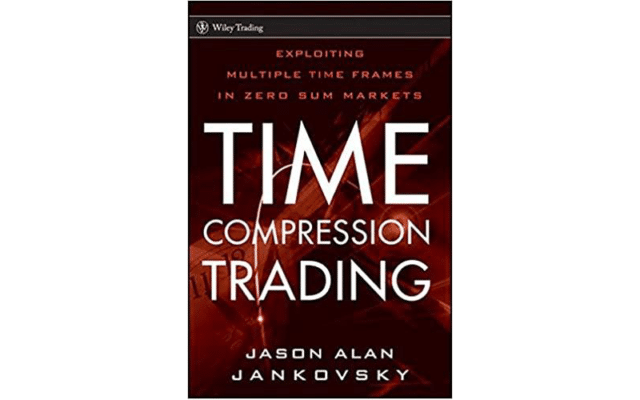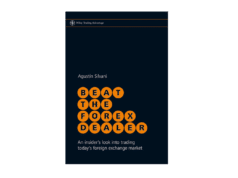‘Time Compression Trading: Exploiting Multiple Time Frames In Zero-Sum Markets’ is a mind-challenging body of work in the financial markets published in 2010. The author, Jason Alan Jankovsky, boasts more than 30 years both as a retail trader and a broker in several leveraged products: forex, futures, and options.
Besides his writing work, the veteran also has several published blogs and videos diving into his other unconventional trading concepts. Jankovsky has written three official books to date, with this one in question being his most recent.
Judging by the title alone, one can tell this publication is not for beginners since the ideas he discusses are advanced and unorthodox. Traders with at least a year’s experience trading any market will undoubtedly resonate with many of the beliefs the author intricately discusses.
In Part 1, this article will look at the more abstract topics covering more or less the first half of the book: the concepts of a zero-sum game, order flow, alternative usage of technical analysis, and time compression.
The concept of a zero-sum market
The first chapter in Jankovsky’s book deals with the idea of a zero-sum market. He concludes forex, options, and futures are examples of instruments fitting this mold. For the most part, this is a rarely discussed notion in the everyday trading literature but is quite crucial to understand.
In the game theory, zero-sum describes a scenario whereby the gains of a player or group equal to the losses of others, resulting in the net change of wealth being zero. For instance, if there are ten accounts worth $10,000 in value, this figure would remain the same by the end of the trading day.
The only difference is some traders will have more while others would have less. Most analysts liken some financial markets to poker because no new money technically gets made. Instead, it is transferred amongst players where there are winners and losers.
Similarly, in trading, no money is ever won or lost, but rather the gains earned by profitable traders come from those who’ve closed their orders at a loss; the winners get paid by the losers.
According to Jankovsky, the point of appreciating a zero-sum market is building a trading approach looking to exploit circumstances where a large number of traders are likely to liquidate their trades, bearing losses.
The author then moves onto an intricate chapter of explaining order flow in the hopes of showing the reader how to use the zero-sum concept to their advantage.
The concept of order flow
Readers can learn some unorthodox ideas in this section. Jankovsky describes the market as ‘an order-processing machine based on a never-ending order flow imbalance.’ He argues at length why the price of an instrument isn’t as important as knowing the aggregate number of buy or sell orders at a particular moment.
Linking from the suggestion of the zero-sum game, he specifies three essential components to order flow and market structure:
- Time
- Volume
- Open interest
Any trader entering a position attempts to answer the question of ‘is the market too high or too low right now?’ In the book, Jankovsky details the significance of why one needs a large set of orders coming in their favor after they’ve opened trade to make any profit.
All a market ever does is process orders from one side and match them with another, which is what causes price changes. The reader will learn how order flow comes into being through how people make trading decisions; ‘the markets are made up of people, not prices.’
The concept of exploiting conventional technical analysis
The writer is never shy to make bold arguments; this is no surprise from someone as experienced and knowledgeable as him. One fascinating chapter in the book is named ‘The Illusion of Technical Analysis,’ where he argues why technical analysis cannot be used consistently to profit, calling it ‘wishful thinking.’
He likens an aspiring analyst to a mathematician, engineer, or statistician who uses ‘variable X’ to solve ‘variable Y.’ The main point of prediction is using a set of constants to solve an unknown variable. He contends the main problem of technical analysis is using ‘variable X’ to solve ‘variable X.’
Fortunately, he doesn’t entirely dismiss technical analysis as it’s still useful in some aspects, though it doesn’t provide a blueprint for how markets are structured. He then explains that instead, we can exploit how most traders use technical analysis to our benefit.
Since everyone more or less sees the same patterns and data, the book explains gaps where one can exploit this herd mentality, which dramatically affects order flow. For instance, one universally accepted idea of technical analysis is breakouts.
Although breakouts do exist, it’s well-known that stop loss hunting often occurs in breakout areas. Stop loss hunting is a big part of order flow. This is only just one example. The point is using technical analysis against the so-called losing analyst.
The concept of time compression
It is only several chapters into reading the book where the writer slowly unveils the meaning of ‘time compression’ as the namesake of his work. Time compression refers to a scenario where people need to do one thing simultaneously for the same reasons.
One of the most vital parts of the entire book is the chapters on forced liquidation, which he describes pretty intricately. The reader will see forced liquidation as how traders liquidate or close their losing or small profit trades when unexpected things occur in the markets.
Specific trigger responses are built to prevent pain or to stimulate pleasure. The triggers are some of the reasons why one liquidates their position. This action is explicitly heightened if the traded instrument has high leverage.
He goes as far as explaining how traders placing new orders doesn’t necessarily cause market movements, but rather it’s them closing losing ones. Forced liquidation results in an order flow imbalance, and according to Jankovsky, this phenomenon appears on multiple time frames.
Final word
To summarise Part 1, the reader will have learned how appreciating zero-sum markets is crucial to how order flow occurs in the markets. Moreover, this order flow is often a result of how ill-informed traders use technical analysis.
Instead, Jankovsky encourages the reader to use this to their advantage. Arguably, the time compression section is the most complex concept of all four to grasp and might need several read-throughs.Stop
The concept merely refers to how traders liquidate their positions after a certain time has passed due to, in most cases, preventing a bigger loss (preventing pain) but also taking a small profit (stimulating pleasure).




